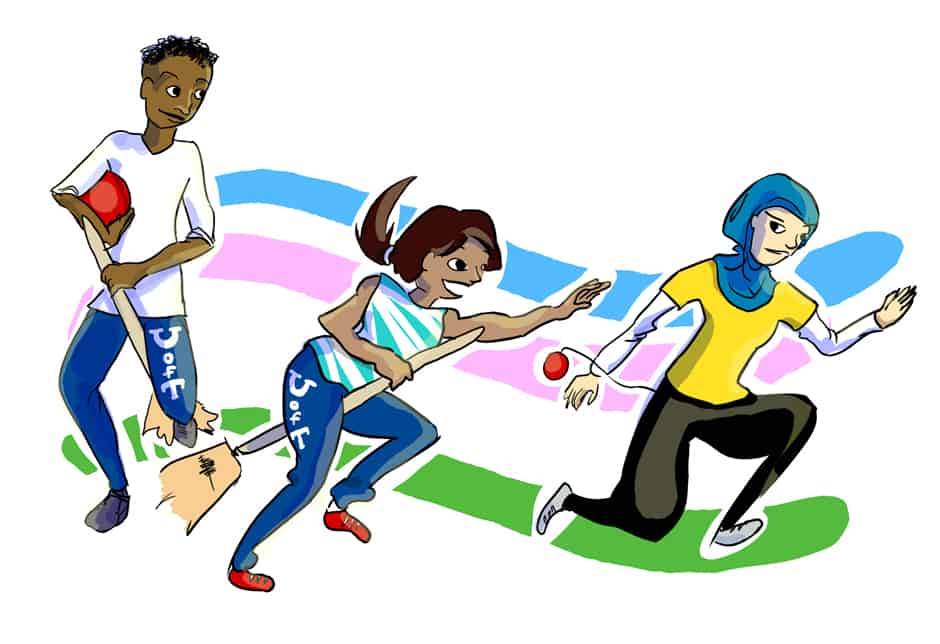The first of JK Rowling’s Harry Potter novels was published in 1997. In the next 10 years, the series exploded into a bona fide cultural phenomenon and a touchstone for millions of children. Here at U of T, the Harry Potter franchise has introduced an endless debate about which of our colleges is really Gryffindor, as well as a new sport to the intramurals repertoire.
Quidditch, of course, is the sport of choice in the wizarding community. In 2005, muggle quidditch made its debut in Vermont. In 2007, the International Quidditch Association (IQA) was formed to regulate the new sport.
In 2009, an embassy of McGill athletes brought the sport to the St. George Campus, and the U of T Nifflers Quidditch team was formed, followed by teams at UTM and UTSC.
SNITCH SPECIFICS
The basic rules of the sport should be familiar to Harry Potter fans. There are seven players on each team: three chasers passing a ball through one of three large raised hoops; one keeper to stop the attempts; two beaters, who throw balls (bludgers) at the opposing team to temporarily remove players from the field; and a seeker, who seeks the golden snitch, the catching of which will end the game.
Rowling’s Snitch is “tiny, about the size of a large walnut… [and with] little fluttering silver wings.”
Muggle snitches are worth 30 points and are rather more visible. “The snitch is a ball attached to the waistband of the snitch runner, a neutral athlete in a yellow uniform who uses any means to avoid capture,” according to the IQA rulebook. Seekers must steal the ball from the snitch runner to make the catch.
Complicating the game for the seekers is the existence of the “snitch perimeter.” For a predetermined time at the beginning of the game, the snitch runner can hide within a pre-established area (including in any buildings) off the pitch, which the seekers must then search. If, at the end of this time, the snitch has not been found and caught, the snitch runner returns to the pitch and the seekers must catch it there.
ON THE FIELD
So what exactly is Quidditch like on the ground? “It’s kind of like a combination of rugby, dodgeball, and wrestling,” said U of T co-captain Sarah Basciano.
“And a bit of tag,” added co-captain Harrison Wade.
All competitors must play with a broom between their legs at all times: “I use my Swiffer,” said Basciano.
Muggle Quidditch is proudly co-ed and progressive — the IQA states: “A Quidditch game requires each team to have at least two players on the field who identify with a different gender than at least two other players.”
The game is chaotic and fast-paced, and often surprisingly physical — tackling is legal and a core part of the game’s strategy.
Injuries occur frequently in the game. Co-captain Matt Korda showed off a finger splint earned while seeking, and fourth co-captain Cole Li has been concussed twice while playing chaser: “That’s one of the reasons I want to change to beating — less chance of injury there,” he said.
Equipment and safety procedures are being standardized and regulated; certified snitch runners are given preference at tournaments. The current IQA rulebook is 117 pages long and in its seventh edition, with the eighth edition about to be adopted.
A GROWING SPORT
The Quidditch community strives for more respect for the sport, and the game’s physicality often helps silence those whose first instinct is to mock. “I do think that one of the toughest things about Quidditch is moving the game away from the books,” says Korda.
All four U of T captains stress their excitement at the way the game is developing. The Nifflers themselves are in the process of rebranding, moving away from their fuzzier mascots towards a new image, soon changing their name to the Centaurs. The name represents a change in attitude: they want to be more competitive, and they also are hoping that a less obscure name might help them attract more attention here at U of T.
The Nifflers’ aspirations echo the aspirations of the sport at large — more fan engagement, more resources, and more participation. Quidditch is new and a little strange, but the community hopes that new fans will embrace the differences — and they seem to be doing so as the sport is continually growing.
Higher-level tournaments have begun to attract public interest. Basciano played beater for Team Canada this summer at the first ever International Global Games in Burnaby.
At U of T, the teams will hold open practices so that newcomers can check out the game. They’re hoping to spread the magic of Quidditch and keep the sport flying high.


